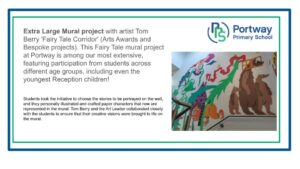Art and Design
The Art and Design curriculum at Portway Primary has been designed to engage, inspire and challenge pupils, equipping them with the knowledge and skills to experiment, invent and create their own works of art, craft and design. It aims to provide the pupils with opportunities to think critically and develop a more rigorous understanding of art and design. Pupils develop an understanding of how art and design both reflect and shape our history, contribute to the culture, creativity and wealth of our nation.
Our Art and Design Curriculum develops essential characteristics of artists:
- The ability to use visual language skillfully and convincingly (for example, line, shape, pattern, colour, texture, form) to express emotions, interpret observations, convey insights and accentuate their individuality.
- The ability to communicate fluently in visual and tactile form.
- The ability to draw confidently and adventurously from observation, memory and imagination.
- The ability to explore and invent marks, develop and deconstruct ideas and communicate perceptively and powerfully through purposeful drawing in 2D, 3D or digital media.
- An impressive knowledge and understanding of other artists, craftmakers and designers.
- The ability to think and act like creative practitioners by using their knowledge and understanding to inform, inspire and interpret ideas, observations and feelings.
- Independence, initiative and originality which they can use to develop their creativity.
- The ability to select and use materials, processes and techniques skillfully and inventively to realise intentions and capitalise on the unexpected.
- The ability to reflect on, analyse and critically evaluate their own work and that of others.
- A passion for and a commitment to the subject.
Our art and design unit coverage provides detailed information as to how we teach all elements of the curriculum across all year groups at our school.
How is Art and Design taught at Portway?
The Art and Design curriculum is designed to help pupils form an Art and Design mental model within their long-term memories.
Schema theory states that all knowledge is organised into units. A mental model is, therefore, a conceptual system for understanding knowledge.
Our Art and Design mental model is a way of organising Art and Design substantive and disciplinary knowledge in a meaningful way; it is an appreciation of how facts are connected and the ways in which they are connected. It is distinct from information, which is just isolated facts that have no organisational basis or links.
Big Ideas help form the basis of the mental model. Big Ideas are key concepts that underpin the subject. There are three Big Ideas in Art and Design:
- Taking inspiration from the Greats (Understanding how ideas develop through analysing art, creating art and using artistic processes.)
- Mastering Practical Skills (Developing practical skills so that ideas can be communicated.)
- Developing Ideas (Understanding how ideas develop through analysing art, creating art and using artistic processes)
Each Big Idea has knowledge strands which help to strengthen the mental model. Learning knowledge in each of the strands allows pupils to express and demonstrate their understanding of the Big Idea, which gradually develops as pupils return to them over and over again.
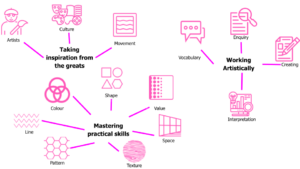
What makes art and design unique at Portway?
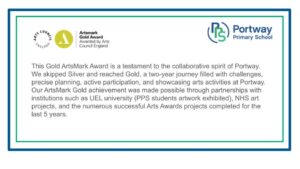
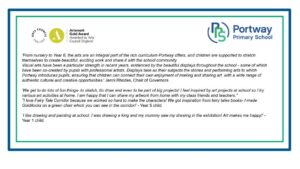
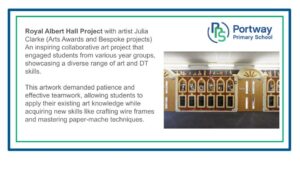
Our Albert Hall project is featured on the Bow Arts website. Other work by our children is also featured.
